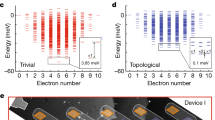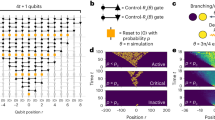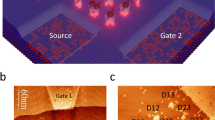Abstract
Tuning a material to the cusp between two distinct ground states can produce physical properties that are unlike those in either of the neighbouring phases. Advances in the fabrication and control of quantum systems have raised the tantalizing prospect of artificial quantum simulators that can capture such behaviour. A tunable array of coupled qubits should have an appropriately rich phase diagram, but realizing such a system with either tunnel-coupled semiconductor quantum dots or metal nanostructures has proven difficult. The challenge for scaling up to clusters or lattices is to ensure that each element behaves essentially identically and that the coupling between elements is uniform, while also maintaining tunability of the interactions. Here we study a nanoelectronic circuit comprising two coupled hybrid metal–semiconductor islands, combining the strengths of both materials to form a potentially scalable platform. The semiconductor component allows for controllable inter-site couplings at quantum point contacts, while the metal component’s effective continuum of states means that different sites can be made equivalent by tuning local potentials. The couplings afforded by this architecture can realize an unusual quantum critical point resulting from frustrated Kondo interactions. The observed critical behaviour matches theoretical predictions, verifying the success of our experimental quantum simulation.
This is a preview of subscription content, access via your institution
Access options
Access Nature and 54 other Nature Portfolio journals
Get Nature+, our best-value online-access subscription
$29.99 / 30 days
cancel any time
Subscribe to this journal
Receive 12 print issues and online access
$209.00 per year
only $17.42 per issue
Buy this article
- Purchase on Springer Link
- Instant access to full article PDF
Prices may be subject to local taxes which are calculated during checkout



Similar content being viewed by others
Data availability
All data used in this work are available in the Stanford Digital Repository at https://doi.org/10.25740/mx151nn9365. Source data are provided with this Paper.
References
Sachdev, S. Quantum Phase Transitions 2nd edn (Cambridge Univ. Press, 2011).
Paschen, S. & Si, Q. Quantum phases driven by strong correlations. Nat. Rev. Phys. 3, 9–26 (2021).
Anderson, P. W. Localized magnetic states in metals. Phys. Rev. 124, 41–53 (1961).
Georges, A. & Sengupta, A. M. Solution of the two-impurity, two-channel Kondo model. Phys. Rev. Lett. 74, 2808–2811 (1995).
Affleck, I. Quantum impurity problems in condensed matter physics. Preprint at https://arxiv.org/abs/0809.3474 (2008).
Gull, E. et al. Continuous-time Monte Carlo methods for quantum impurity models. Rev. Mod. Phys. 83, 349–404 (2011).
Meirav, U., Kastner, M. A. & Wind, S. J. Single-electron charging and periodic conductance resonances in GaAs nanostructures. Phys. Rev. Lett. 65, 771–774 (1990).
Goldhaber-Gordon, D. et al. Kondo effect in a single-electron transistor. Nature 391, 156–159 (1998).
Cronenwett, S. M., Oosterkamp, T. H. & Kouwenhoven, L. A tunable Kondo effect in quantum dots. Science 281, 540–544 (1998).
Sasaki, S. et al. Kondo effect in an integer-spin quantum dot. Nature 405, 764–767 (2000).
Jeong, H., Chang, A. M. & Melloch, M. R. The Kondo effect in an artificial quantum dot molecule. Science 293, 2221–2223 (2001).
Oreg, Y. & Goldhaber-Gordon, D. Two-channel Kondo effect in a modified single electron transistor. Phys. Rev. Lett. 90, 136602 (2003).
Potok, R. M., Rau, I. G., Shtrikman, H., Oreg, Y. & Goldhaber-Gordon, D. Observation of the two-channel Kondo effect. Nature 446, 167–171 (2007).
Buizert, C., Oiwa, A., Shibata, K., Hirakawa, K. & Tarucha, S. Kondo universal scaling for a quantum dot coupled to superconducting leads. Phys. Rev. Lett. 99, 136806 (2007).
Takada, S. et al. Transmission phase in the Kondo regime revealed in a two-path interferometer. Phys. Rev. Lett. 113, 126601 (2014).
Keller, A. J. et al. Emergent SU(4) Kondo physics in a spin–charge-entangled double quantum dot. Nat. Phys. 10, 145–150 (2013).
Mitchell, A. K., Liberman, A., Sela, E. & Affleck, I. SO(5) non-Fermi liquid in a coulomb box device. Phys. Rev. Lett. 126, 147702 (2021).
Keller, A. J. et al. Universal Fermi liquid crossover and quantum criticality in a mesoscopic system. Nature 526, 237–240 (2015).
Iftikhar, Z. et al. Two-channel Kondo effect and renormalization flow with macroscopic quantum charge states. Nature 526, 233–236 (2015).
Iftikhar, Z. et al. Tunable quantum criticality and super-ballistic transport in a ‘charge’ Kondo circuit. Science 360, 1315–1320 (2018).
Landau, L. A., Cornfeld, E. & Sela, E. Charge fractionalization in the two-channel Kondo effect. Phys. Rev. Lett. 120, 186801 (2018).
Mitchell, A. K., Landau, L. A., Fritz, L. & Sela, E. Universality and scaling in a charge two-channel Kondo device. Phys. Rev. Lett. 116, 157202 (2016).
Zhang, G. et al. Nonequilibrium quantum critical steady state: transport through a dissipative resonant level. Phys. Rev. Res. 3, 013136 (2021).
Burdin, S., Georges, A. & Grempel, D. R. Coherence scale of the Kondo lattice. Phys. Rev. Lett. 85, 1048–1051 (2000).
Stafford, C. A. & Das Sarma, S. Collective Coulomb blockade in an array of quantum dots: a Mott-Hubbard approach. Phys. Rev. Lett. 72, 3590–3593 (1994).
Hensgens, T. et al. Quantum simulation of a Fermi–Hubbard model using a semiconductor quantum dot array. Nature 548, 70–73 (2017).
Pateras, A. et al. Electrode-induced lattice distortions in GaAs multi-quantum-dot arrays. J. Mater. Res. 34, 1291–1301 (2019).
Inoshita, T., Shimizu, A., Kuramoto, Y. & Sakaki, H. Correlated electron transport through a quantum dot: the multiple-level effect. Phys. Rev. B 48, 14725–14728 (1993).
Furusaki, A. & Matveev, K. Theory of strong inelastic cotunneling. Phys. Rev. B 52, 16676–16695 (1995).
Jones, B. A., Varma, C. M. & Wilkins, J. W. Low-temperature properties of the two-impurity Kondo Hamiltonian. Phys. Rev. Lett. 61, 125–128 (1988).
Glazman, L. & Matveev, K. Lifting of the Coulomb blockade of one-electron tunneling by quantum fluctuations. Sov. Phys. JETP 71, 1031–1037 (1990).
Matveev, K. A. Quantum fluctuations of the charge of a metal particle under the Coulomb blockade conditions. Sov. Phys. JETP 72, 892–899 (1991).
Zaránd, G., Chung, C.-H., Simon, P. & Vojta, M. Quantum criticality in a double-quantum-dot system. Phys. Rev. Lett. 97, 166802 (2006).
Jayatilaka, F. W., Galpin, M. R. & Logan, D. E. Two-channel Kondo physics in tunnel-coupled double quantum dots. Phys. Rev. B 84, 115111 (2011).
Bulla, R., Costi, T. A. & Pruschke, T. Numerical renormalization group method for quantum impurity systems. Rev. Mod. Phys. 80, 395–450 (2008).
Mitchell, A. K., Galpin, M. R., Wilson-Fletcher, S., Logan, D. E. & Bulla, R. Generalized Wilson chain for solving multichannel quantum impurity problems. Phys. Rev. B 89, 121105 (2014).
Mitchell, A. K., Pedersen, K. G., Hedegård, P. & Paaske, J. Kondo blockade due to quantum interference in single-molecule junctions. Nat. Commun. 8, 15210 (2017).
Averin, D. & Odintsov, A. Macroscopic quantum tunneling of the electric charge in small tunnel junctions. Phys. Lett. A 140, 251–257 (1989).
Averin, D. & Nazarov, Y. V. Virtual electron diffusion during quantum tunneling of the electric charge. Phys. Rev. Lett. 65, 2446–2449 (1990).
Child, T. et al. Entropy measurement of a strongly correlated quantum dot. Phys. Rev. Lett. 129, 227702 (2022)
Han, C. et al. Fractional entropy of multichannel Kondo systems from conductance-charge relations. Phys. Rev. Lett. 128, 146803 (2022).
Karki, D. B., Boulat, E. & Mora, C. Double-charge quantum island in the quasiballistic regime. Phys. Rev. B 105, 245418 (2022).
Emery, V. J. & Kivelson, S. Mapping of the two-channel Kondo problem to a resonant-level model. Phys. Rev. B 46, 10812–10817 (1992).
Coleman, P., Ioffe, L. B. & Tsvelik, A. M. Simple formulation of the two-channel Kondo model. Phys. Rev. B 52, 6611–6627 (1995).
Maier, T. in Many-Body Physics: From Kondo to Hubbard Vol. 5 (eds Pavarini, E. et al.) Ch. 14 (Forschungszentrum Jülich, 2015).
Sénéchal, D. in Many-Body Physics: From Kondo to Hubbard Vol. 5 (eds Pavarini, E. et al.) Ch. 13 (Forschungszentrum Jülich, 2015).
Wilson, K. G. The renormalization group: critical phenomena and the Kondo problem. Rev. Mod. Phys. 47, 773–840 (1975).
Stadler, K. M., Mitchell, A. K., von Delft, J. & Weichselbaum, A. Interleaved numerical renormalization group as an efficient multiband impurity solver. Phys. Rev. B 93, 235101 (2016).
Galpin, M. R. et al. Conductance fingerprint of Majorana fermions in the topological Kondo effect. Phys. Rev. B 89, 045143 (2014).
Weichselbaum, A. & von Delft, J. Sum-rule conserving spectral functions from the numerical renormalization group. Phys. Rev. Lett. 99, 076402 (2007).
Minarelli, E. L., Rigo, J. B. & Mitchell, A. K. Linear response quantum transport through interacting multi-orbital nanostructures. Preprint at https://arxiv.org/abs/2209.01208 (2022).
Pioro-Ladrière, M. et al. Origin of switching noise in GaAs/AlxGa1 − xAs lateral gated devices. Phys. Rev. B 72, 115331 (2005).
Iftikhar, Z. et al. Primary thermometry triad at 6 mK in mesoscopic circuits. Nat. Commun. 7, 12908 (2016).
Joyez, P. & Esteve, D. Single-electron tunneling at high temperature. Phys. Rev. B 56, 1848–1853 (1997).
Souquet, J.-R., Safi, I. & Simon, P. Dynamical Coulomb blockade in an interacting one-dimensional system coupled to an arbitrary environment. Phys. Rev. B 88, 205419 (2013).
Altimiras, C., Gennser, U., Cavanna, A., Mailly, D. & Pierre, F. Experimental test of the dynamical Coulomb blockade theory for short coherent conductors. Phys. Rev. Lett. 99, 256805 (2007).
Senkpiel, J. et al. Dynamical Coulomb blockade as a local probe for quantum transport. Phys. Rev. Lett. 124, 156803 (2020).
Jezouin, S. et al. Tomonaga–Luttinger physics in electronic quantum circuits. Nat. Commun. 4, 1802 (2013).
Flensberg, K., Girvin, S. M., Jonson, M., Penn, D. R. & Stiles, M. D. Quantum mechanics of the electromagnetic environment in the single-junction Coulomb blockade. Phys. Scripta 1992, 189 (1992).
Yeyati, A. L., Martin-Rodero, A., Esteve, D. & Urbina, C. Direct link between Coulomb blockade and shot noise in a quantum-coherent structure. Phys. Rev. Lett. 87, 046802 (2001).
Pekola, J. P., Holmqvist, T. & Meschke, M. Primary tunnel junction thermometry. Phys. Rev. Lett. 101, 206801 (2008).
Golubev, D. S. & Zaikin, A. D. Electron transport through interacting quantum dots in the metallic regime. Phys. Rev. B 69, 075318 (2004).
Devoret, M. H. et al. Effect of the electromagnetic environment on the Coulomb blockade in ultrasmall tunnel junctions. Phys. Rev. Lett. 64, 1824–1827 (1990).
Parmentier, F. D. et al. Strong back-action of a linear circuit on a single electronic quantum channel. Nat. Phys. 7, 935–938 (2011).
Slobodeniuk, A. O., Levkivskyi, I. P. & Sukhorukov, E. V. Equilibration of quantum Hall edge states by an Ohmic contact. Phys. Rev. B 88, 165307 (2013).
Acknowledgements
We thank F. Pierre, I. Safi, G. Zarand, C. P. Moca, I. Weymann, P. Sriram, E. Sela, Y. Oreg, Q. Si, C. Varma and C. Mora for their scientific insights and suggestions. To make this project work, before coupling two islands we had to start by reproducing F. Pierre’s tour de force experiments on single islands of the same type. F. Pierre helped with comments on our fabrication process, measurement procedure and analysis. Discussions with C. Mora led to improvements in our analysis of the periodic Fermi-liquid scale. We acknowledge G. Zarand, C. P. Moca and I. Weymann for early discussions of the Hamiltonian and its implications. Measurement and analysis were supported by the US Department of Energy (DOE), Office of Science, Basic Energy Sciences (BES), under contract no. DE-AC02-76SF00515. Growth and characterization of heterostructures was supported by the French Renatech network. Theory and computation (A.K.M.) were supported by the Irish Research Council Laureate Awards 2017/2018 through grant no. IRCLA/2017/169. Part of this work was performed at the Stanford Nano Shared Facilities (SNSF), supported by the National Science Foundation under award ECCS-2026822. Early research that established how to meet the demanding technical conditions for sample fabrication and basic measurements was supported by the National Science Foundation (NSF) under award no. 1608962. W.P. acknowledges support from the Fletcher Jones Fellowship. C.L.H. acknowledges support from the Gabilan Fellowship. L.P. acknowledges support of the Albion Walter Hewlett Fellowship.
Author information
Authors and Affiliations
Contributions
W.P. and L.P. performed the measurements. L.P. fabricated the device. A.K.M. developed the theory and carried out NRG calculations. W.P., L.P., C.L.H., M.A.K., A.K.M. and D.G.-G. analysed the data. A.C. and U.G. grew the heterostructure that hosts the 2DEG on which these samples are built. D.G.-G. supervised the project.
Corresponding authors
Ethics declarations
Competing interests
The authors declare no competing interests.
Peer review
Peer review information
Nature Physics thanks Takis Kontos and the other, anonymous, reviewer(s) for their contribution to the peer review of this work.
Additional information
Publisher’s note Springer Nature remains neutral with regard to jurisdictional claims in published maps and institutional affiliations.
Extended data
Extended Data Fig. 1 Schematic illustrations of the models discussed.
a, The DCK model consists of six effectively independent spinless conduction electron reservoirs (blue for island, red for lead), described by fermionic operators fαγ and cα for α = L, R and γ = l, i. Tunneling occurs at each of the three QPCs controlled by JL,C,R. The island charging energy \({E}_{C}^{\alpha }\) correlates electrons fαi and cα on the same island either side of the metal component (black bar). b, At a TP, Eq. (9) describes the system at low temperatures. The three retained charge states of the two-island structure (denoted \(\left\vert A\right\rangle ,\left\vert B\right\rangle ,\left\vert C\right\rangle\)) are interconverted by QPC tunneling. The frustrated QCP arises when JL = JR = JC ≡ J. The conductive pathway \(\left\vert A\right\rangle \to \left\vert B\right\rangle \to \left\vert C\right\rangle\) corresponds to transport from left lead to right lead, and is illustrated with the blue arrows (the flow is reversed \(\left\vert C\right\rangle \to \left\vert B\right\rangle \to \left\vert A\right\rangle\) by changing the sign of the applied bias voltage).
Extended Data Fig. 2
SEM micrograph of nominally identical device. The acceleration voltage in the SEM was 5 kV.
Extended Data Fig. 3 Dynamical Coulomb blockade of QPC transmissions.
a. Measured QPC transmissions τR, τL as a function of a source-drain bias VSD for different QPC gate voltages. The measured transmission is extracted by measuring the series conductance when in series with the inter-island QPC and opposite island-lead QPC set to fully transmit a single channel (τC,L/R = 1). The measured transmissions clearly dip at zero bias, consistent with dynamical Coulomb blockade (DCB) behavior. The high bias behavior (VSD ≈ 50μV) recovers the ‘intrinsic’ transmission of the QPC, unrenormalized by DCB. b. DCB measurements comparing the right island-lead QPC to the inter-island QPC. It is clear there is a substantial difference in the DCB-renormalization at zero bias between the two, likely due to the device geometry. c. Comparison of measuring τR through both islands (blue lines, as in a, b) and through the adjacent plunger gate PR (red lines). While typically we would expect no significant bias dependence when measuring through PR, we in fact see DCB-like behavior. d. Comparing the two measurement pathways of c at fixed source-drain bias as a function of the QPC gate voltage. The ‘through the island’ (blue) measurements have been shifted by 9mV to account for the large capacitive cross-talk effect when switching between the two different measurement pathways. That the high bias traces match well is indicative that there is indeed DCB-renormalization of the transmission when measuring through PR. Empirically, using the zero bias, ‘through the plunger gate’ measurement of the transmission (solid red line), best captures the relevant transmissions in the Kondo interactions of our system.
Extended Data Fig. 4 Semi-universal τC values.
Supplementary information
Supplementary Information
Supplementary discussion and Figs. 1–7
Supplementary Data 1
Statistical source data.
Supplementary Data 2
Statistical source data.
Supplementary Data 3
Statistical source data.
Supplementary Data 4
Statistical source data.
Supplementary Data 5
Statistical source data.
Supplementary Data 6
Statistical source data.
Supplementary Data 7
Statistical source data.
Source data
Source Data Fig. 1
Statistical source data.
Source Data Fig. 2
Statistical source data.
Source Data Fig. 3
Statistical source data.
Source Data Extended Data Fig./Table 3
Statistical source data.
Source Data Extended Data Fig./Table 4
Statistical source data.
Rights and permissions
Springer Nature or its licensor (e.g. a society or other partner) holds exclusive rights to this article under a publishing agreement with the author(s) or other rightsholder(s); author self-archiving of the accepted manuscript version of this article is solely governed by the terms of such publishing agreement and applicable law.
About this article
Cite this article
Pouse, W., Peeters, L., Hsueh, C.L. et al. Quantum simulation of an exotic quantum critical point in a two-site charge Kondo circuit. Nat. Phys. 19, 492–499 (2023). https://doi.org/10.1038/s41567-022-01905-4
Received:
Accepted:
Published:
Issue Date:
DOI: https://doi.org/10.1038/s41567-022-01905-4
This article is cited by
-
Hierarchical entanglement shells of multichannel Kondo clouds
Nature Communications (2023)



